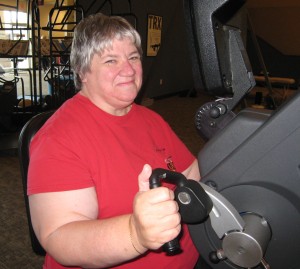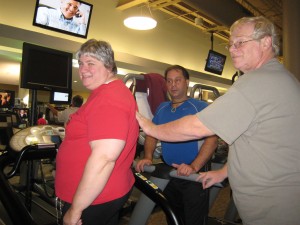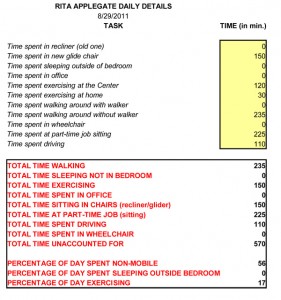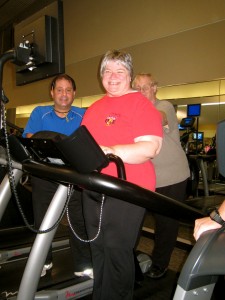by Michelle Sutton-Kerchner
Battling countless afflictions, member Rita shares how she (literally) got herself up from the ground and became a survivor. More than once. In life’s make-or-break moments, how do you react? Build up your resilience. Be inspired by Rita’s story of hope…
We all know that person– always smiling, cheerful, and exuding energy. We also know the person standing alongside who wants to choke their peppy attitude with a good dose of pessimism (or what they may consider “reality”).
Our emotional makeup may seem hardwired in our personalities. However, it’s not impossible to transform your reflective thinking, the knee-jerk response of your brain. With a little practice, you can self-talk your way to a more productive mental state. Focus on the positive, which we tend to experience more frequently. In times of need, this bank of affirmations reminds us that one frustration, setback, or loss does not need to turn all emotions negative.
Resilient people do indeed mourn and indulge in self-pity. However, they don’t let it overtake them. They remember life’s positive moments and recognize the ability to enjoy them again, perhaps in a different way. According to Dr. David Sabine, a clinical psychologist in Texas, resilient people look toward pain instead of running from it. This results in refusal to accept the situation without working on a solution. The process of working through it builds confidence and propels one further toward overcoming it.
Rising Back Up

Professional dancer, theater choreographer, martial arts studio owner and practitioner, lifelong go-getter. That describes member Rita Applegate, until her thirtieth year. Despite being born with severe bone deformities from the waist down, she lived an active life that challenged her body with rigorous physical activity.
Rita acknowledged she could shift her foot 180 degrees backwards and do other “tricks.” Yet, she continued with regular exercise and strenuous activities. Then, at 30 years old, she collapsed and couldn’t get up. The next 21 months were spent in traction.
Multiple physicians informed Rita she’d never walk again. She had countless health problems that stemmed from bone deformities. Her condition seemed insurmountable. However, not being one to sit around, a permanent wheelchair was not an option.
“I refused to make that wheelchair my home,” shares Rita who thrived on traveling and living an active life. She joined the Center after trying other fitness and physical therapy facilities without meeting her goals. The Center’s aquatic program sealed the deal. In the water, Rita could move.
Her goal upon joining was to lose 10 pounds so she could use the mobile carts offered to the handicapped at public venues. Clearly, Rita surpassed that goal but not without her share of additional obstacles.
Cancer Strikes
“Personal Trainer Eddie Camaroto saved my life, twice,” insists Rita. Yes, she met the 10-pound weight loss requirement for a mobile chair — and lost another 50 pounds. In the process, she completely eliminated her need for a wheelchair. She now walks with a cane or independently. Simultaneous with these accomplishments, Rita was diagnosed with breast cancer.

Her work with Eddie allowed the mobility needed to undergo radiation treatments. Lifting her arms overhead and improving range-of-motion became a necessity. The radiation required positioning that was painful for Rita because of her bone deformities. “Eddie worked my muscles to get me through those 3.5 months of hell [cancer treatments]. He was a God-send,” informs Rita.
According to Rita’s experience, medication for her breast cancer had adverse effects, including the onset of diabetes and liver failure. It also possibly triggered uterine cancer. At Eddie’s urging, Rita sought second opinions. She no longer accepted her symptoms as typical cancer patient struggles. Upon hearing Rita was not monitoring her blood sugar, Eddie urged her to immediately buy a meter to check it. She bought one on her way home and found her blood sugar at a life-threatening level.
Rita’s faith in Eddie grew stronger. He consulted with her physicians, including her surgeon prior to surgery. Eddie advised on Rita’s best positioning on the operating table based on her physical capabilities.
Eddie continues to provide input to Rita’s team of physicians. Together, they direct her toward her healthiest life, regardless of limitations or diagnosis. “Rita is an amazing person. An inspiration to all,” shares Eddie. “She finds strength and proceeds through the pain. ”
When asked what sets Rita, and other resilient types apart, Eddie notes it’s about fortitude. He sees many successes on the Exercise Floor.”It’s there for everyone. You need to reach deep inside yourself and pull out that strength to keep you going.” Pain in life is inevitable. Suffering is always optional.
Support Network

A commonality among the resilient: Support. It comes in all forms. For Rita, it’s a loving, dedicated husband (co-owner of their previous martial arts studio) and a great team at the Center, led by Eddie. “I’d put my life in Eddie’s hands,” she shares. After three years of this training partnership, they’ve all developed an intense dedication to her success.
At Eddie’s recommendation, Rita began to keep an album of her successes. Through this visualization, she can witness gaining her life back. The lost weight, eliminated wheelchair, abandoned cane, greatly reduced medications, and conquered diabetes and cancers reflect sheer determination. They are the silver lining, essential for resilient thinking. The best part — Rita considers herself happy.
“Rita doesn’t always see her progress. Sometimes, other members approach Rita and remind her of her immobile status not so long ago. They know her. She’s a walking inspiration,” says Eddie. And when those bad days hit, as they do for all of us, Rita has no shame about spending them at the Center. “I can stay home and cry, or be supported by friends at the Center who can lift my spirits. I feel comfortable in such a caring environment. I can be myself.” She adds,” Eddie is my medicine.”
Having others rally around you also adds an element of accountability. According to Eddie, Rita doesn’t like to disappoint. She wants to impress others. This mentality thrives in a wellness community that shares your goals and hopes.

At Eddie’s request, Rita keeps a log of her sedentary hours. During her 25-year decline, she became accustomed to sitting still for 12 to 18 hours a day. Through nightly e-mails to Eddie with her daily mobility, they worked this down to eight hours a day or less. “Rita’s day is filled with exercise regimens stricter than those of some athletes. What she overcomes every day is incredible. Regardless of the pain she experiences, she gets up and does it again,” says Eddie.
As a wellness facility, the Center is available even after you exit. Eddie takes pride connecting in a way that allows pleasant and productive team work. Incidentally, Eddie will be joining Rita and her husband at a chocolate festival this fall in Pennsylvania. “It’ll be great to see her function in her world. I’ve opened doors, but she’s the one who needs to walk through them. I enjoy witnessing that first-hand, whether at a chocolate fest or on the Exercise Floor.”
Strengthen those connections. Your life could depend on it. A 2006 study of nearly 3,000 breast cancer patients found those with 10 or more friends were four times more likely to survive the disease than those without close friends.
Recreate Your World
Barbara Fredrickson, PhD and self-help author, indicates resilience is different than “succumbing to Pollyanna-ish denial. The resilient person isn’t papering over emotions, but instead letting them sit side-by-side with other feelings.” They don’t let their illness or situation define them. Acknowledge the bad days. They’ll happen. As Rita exemplifies, you can’t afford to let them last or become your entire person.
Rita has learned much from her experience at the Center, which has allowed her to make it a lifestyle beyond the facility’s physical presence. Her can-do attitude translated into remodeling at home so she can still enjoy scrapbooking via an elevated platform. She ergonomically reorganized the office at her place of employment.
Beaming, Rita rode a merry-go-round for the first time in 35 years. Her personal training work is transforming her abilities. She is getting her life back. “I love the merry-go-round.” Tears of joy streamed down her face as she rode the amusement to the carnivalesque music.
Deformities like Rita’s are so severe (including bones growing through her tendons), they are beyond repair. Aware that she’ll never be perfect (and who is), she constructs a world that is perfect for her. Simply knowing there is more to her life than illness and confinement is motivating. Small steps lead to huge accomplishments.

Just last week, on her fifty-third birthday, Rita found herself on the treadmill with Eddie and a small crowd surrounding her. It was on the lowest setting for a mere few minutes, but she was using it. She, who became a member to lose 10 pounds for mobile chair access, was now using the treadmill.
Build Your Resiliency
How can you be more like Rita? Practice healthy habits. This is critical to mental and physical resilience. Many folks come through an accident or tragedy (mental or physical) and attribute a strong, healthy pre-existence as their key to survival. Take time daily for your health. Despite her condition, Rita danced and intensely exercised until she could no longer.
Eat well, sleep enough, and exercise regularly. This provides the fortitude to float rather than sink during times of trouble. Research also proves the need for mental breaks. Our brains are surprisingly active when we relax and rest, particularly in regions associated with decision-making, memories, and emotional processing. You actually use 30 percent more caloric energy than when using other parts of the brain.
Experts infer these mental thought processes improve our ability to solve and respond to problems. Sometimes doing nothing is really something. That’s the foundation of meditation, after all.
Do what you enjoy. Find a way to make the little things happen. Rita was thrilled when able to grocery shop with her husband. Something like a trip to the store becomes a gift after 10 years of inability.
Eddie advises, “Paint it. See it. Want to live it.” He notes resilient people tend to have a dreamscape, perhaps conjured up during those aforementioned mental breaks. When working through a tragedy, continuously set small goals. They are the brush strokes that help create the bigger picture of your future.
Sources
“The Five Best Ways to Build Resiliency,” by Jessie Sholl, Experience Life, September 2011.
Image Credit
Resilient tree (introductory photo): http://www.flickr.com/photos/alphab/3944852827/
 Fitness & Wellness News Your Source for Fitness News, Wellness News, Health News, and Nutrition News!
Fitness & Wellness News Your Source for Fitness News, Wellness News, Health News, and Nutrition News!



